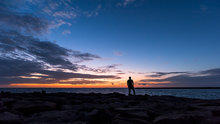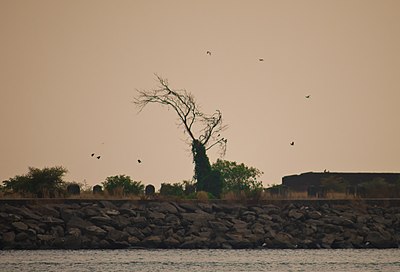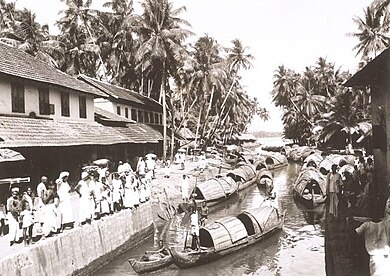Ponnani
It is situated at the estuary of Bharatappuzha (River Ponnani), on its southern bank, and is bounded by the Arabian Sea on the west and a series of brackish lagoons in the south.
In the Middle Ages, under the ambitious Hindu chiefs of Kozhikode (the Samutiris/Zamorins), Ponnani developed as one of the most important centers of Muslim trade - both overseas and domestic - on the Arabian Sea.
The relentless battles lead to the eventual decline of the settlement, with the exodus of Middle Eastern merchants, and the rulers who protected it.
[8][9][10][11] The original headquarters of the Perumbadappu Swaroopam, who later became the Kingdom of Cochin, was at Chithrakoodam in Vanneri, Perumpadappu, which is located 10 km south to Puthuponnani, in Ponnani taluk.
Makhdum II is known for his formidable historical chronicle Tuhfat al-Mujahidin ("Glory to the Victory of Mujahidun", c. 1583), first printed and published in Lisbon.
[17] Ponnani's location at estuary of the Bharatappuzha amidst the fertile plains suitable for rice cultivation might have attracted early settlers.
It is known that the river mouth - situated opposite to the plains of Coimbatore across the Ghat mountains - was accessed by the rulers of central Tamil Nadu through the Palghat Gap.
[21] Pliny the Elder (1st century CE) states that the port of Tyndis was located at the northwestern border of Keprobotos (Chera dynasty).
[26][27] An inscription which dates back to 932 CE, found from Triprangode, mentions Goda Ravi of Chera dynasty and Thavanur.
[28] Several inscriptions written in Old Malayalam those date back to the 10th century CE, have found from Sukapuram near Ponnani, which was one of the 64 old Nambudiri villages of Kerala.
An arrangement was reached between the Brahmin and the Samutiri, as a result of which, the former was obliged to protect the interests of the latter against the neighboring chiefs of Valluvanatu (South Malabar) and Perumpatappu (Cochin).
Muhammad and his brother were forced to leave Cochin and settle at Ponnani in the wake of the Portuguese occupation of the place which had resulted in the destruction of his ships and warehouses.
The Marakkars later moved his base to Kozhikode and when Ponnani was sacked by de Menezes (1525), he offered help to the Samutiri in his fight against the Portuguese.
[33] Towards the end of year 1507, Viceroy Francisco de Almeida was informed that a column of 13 Muslim ships had taken cargo - mainly spices - from Ponnani and were about to leave for the Red Sea.
[34] Ponnani at the time was defended by a strong battery of artillery (forty guns), and a number of well-armed ships under Kutti Ali.
[32] Portuguese Viceroy Henrique de Meneses appeared off the coast of Ponnani on 25 February 1525 with a fleet of 50 ships, including 19 grabs supplied by the chief of Purakkad.
[13][32] Next morning (26 February), the Portuguese landed in forces, and a fierce engagement took place the newly developed base at Ponnani.
Thirty-eight ships belonging to Chinna Kutti Ali were burnt; a large number of Mappilas were killed, the coconut trees on either bank of the River Ponnani were cut by the Cochin Nairs, and houses, shops and mosques were all destroyed.
The Portuguese Viceroy Garcia de Noronha signed a peace treaty with the Samutiri of Kozhikode on board the ship St. Mattheus at Ponnani on 1 January 1540.
[34][9] Terms of the Treaty (1540) In 1552, the Samutiri of Kozhikode received assistance in heavy guns landed at Ponnani, brought by certain Yoosuf, a Turk, who had sailed against the monsoon winds.
[32][36] It is also known that Gil Eanes Mascarenhas opened fire from his ships to Ponnani port and killed large number of natives in 1582.
[13] The Portuguese had earlier (around 1528, under da Cunha) tried to construct a fort on the north bank of the Vaikkal river mouth at Ponnani.
[13] Dom Jeronimo Mascaranhas, who was instrumental in signing the contract with the ruler of Kozhikode, was appointed the Captain of the Factory at Ponnani.
Goncalves proceeded to Ponnani, from where he dispatched a message to the Samutiri of Kozhikode, informing him of the object of his visit, and requesting that he would meet him with the view of selecting a suitable site.
[38][34] Gasper Fagundes, who was in the Ponnani Fort in 1586, was asked by the Portuguese Governor to offer his services to the Samutiri of the Kozhikode against the Kunhali Marakkar.
The aim of the residency was to keep "peace" with the Samutiri of Kozhikode and to watch the activities of the other European powers and the native enemies of the Dutch Company.
[16] On 8 March 1747, it was the Dutch Resident at Ponnani who reported to the Malabar Council the plan of the Samutiri of Kozhikode to occupy by surprise the Fort Chetwai under the pretext of going to Cochin.
The ticket costs only 4 annas, although the distance is 10 km...Ponnani was a major hub of Indian nationalist movement in Malabar District during the British Raj.
The ashes of Mahatma Gandhi, Jawaharlal Nehru, and Lal Bahadur Shastri, were deposited in Kerala at Tirunavaya, on the bank of the river Bharathappuzha.
[11] K. V. Raman Menon (1900–1974), known as Ponnani Gandhi, was a reputed Indian National Congress leader of the time who had actively participated in the freedom movement against the British in Malabar District.






















